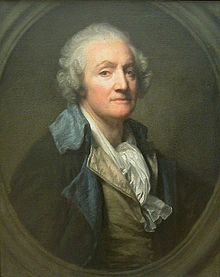Jean-Baptiste Greuze

Jean-Baptiste Greuze (born August 21, 1725 in Tournus (Saône-et-Loire), † March 21, 1805 in Paris ) was a French painter .
Life

Greuze came from a large family. At his father's request he was to become an architect , but after long disputes Greuze was able to prevail and was allowed to become a painter. He came to Lyon as an apprentice in the studio of the painter Charles Grandon .
At the age of 25, on Grandon's recommendation, Greuze was accepted in Paris at the Académie royale de peinture et de sculpture as a student of the affiliated École Royale de Peinture et de Sculpture . For the most part he was tutored there by Charles Joseph Natoire . Under his guidance, Greuze's most famous early work was written in 1755, father of a family, interpreting the Bible for his children . He tried in vain to get a job there through Louis de Silvestre , the drawing teacher at court.
At the end of 1755 Greuze went on a study trip to Italy, specifically to study ancient artists. After stays in Florence and Rome - both cities he said were uninteresting - he settled in Naples for a few months . In 1757 Greuze returned to Paris, where he worked as a freelance painter and married a few years later. The future painter Anna Greuze was his daughter. The marriage was divorced in 1793.

In his artistic work, still completely connected to the Rococo , Greuze went out of fashion very quickly. The zenith of his career had already passed when he took part in the exhibition of the Paris Salon in 1765 and at the same time exhibited at the Académie royale . For admission to the Académie royale , he was required to submit a test work (a picture on a specific topic). After a long warning, Greuze delivered the desired picture in 1768 and gave it the detailed title The Emperor Severus accuses his son Caracalla of wanting to have him murdered in the mountain narrow and says to him: If you want my death, Papinian orders me to kill with this sword. Only a few weeks later, Greuze was finally accepted as a full member of the Académie royale .
Like many of his contemporaries, Greuze had speculated on assignats and lost what little he had. Greuze was initially enthusiastic about the French Revolution , until he lost all his belongings due to the political circumstances. At that time Greuze earned his living almost exclusively from painting and drawing lessons. One of his most famous students was Constance Mayer . Around 1800 she moved to the studio of Pierre Paul Prud'hon , one of his eternal competitors. In 1804/05 Greuze tried in vain to offer himself to the new government with the picture The First Consul Napoleon .
At the age of almost 80, the painter Jean Baptiste Greuze died on March 21, 1805 in bitter poverty in Paris. Jacques Dumont and Jean Simon Berthelemy paid their last respects as the only friends.
Although Greuze was enthusiastic about the ideas of the enlighteners Denis Diderot and Jean-Jacques Rousseau , he remained stuck with the descriptions of the bourgeois milieu throughout his artistic work. He was known for his depictions of young girls and women; many of them were modeled on his student Constance Mayer.
He was a member of the Parisian Masonic Lodge Neuf Sœurs .
Works (selection)
- The wavering virtue
- The village wedding
- The father's curse (the opposite of the next)
- The repentant returning son
- The broken jar
- The ungrateful son
- The beloved mother
- Little girl with a black towel around her shoulders
- A gouty age
- Father of a family, laying out the Bible to his children
- The emperor Severus holding his son accountable
- The dead bird
gallery
literature
- Emma Barker: Greuze and the painting of sentiment. University Press, Cambridge 2005, ISBN 0-521-55508-6 .
- Anita Brookner : Greuze: The Rise and Fall of an Eighteenth-Century Phenomenon . 1972, ISBN 0-236-17678-1 .
- Angelika Euchner: Investigation of the work of Jean Baptiste Greuzes (1725–1805), especially his motives for death. University dissertation, Freiburg / B. 1989.
- Camille Mauclair : Greuze et son temps . A. Michel, Paris 1935.
- Friedrich Sieburg : Greuze and Diderot , Manesse-Verlag, Zurich 1989, ISBN 3-7175-8148-1 .
- James Thompson: Jean Baptiste Greuze. MOMA, New York 1990.
Web links
- Works by Jean-Baptiste Greuze at Zeno.org .
Individual evidence
- ↑ See Commons: File: Anne Geneviève Greuze mother and son with bird chicks.jpg .
- ↑ a b French original title: "L'Empereur Sévère reproche à Caracalla son fils, d'avoir voulu l'assassiner dans les défilés d'Écosse, et lui dit: Si tu desires ma mort, ordonne à Papinien de me la donner avec cette épée ". See: Pablo Schneider, Philipp Zitzlsperger (eds.): Bernini in Paris: the diary of Paul Fréart de Chantelou about the stay of Gianlorenzo Bernini at the court of Louis XIV. Berlin: Akad.-Verl. 2006, p. 395.
- ↑ Alexander Giese: The Freemasons. Böhlau Verlag, Vienna 1997, ISBN 3-205-98598-2 .
| personal data | |
|---|---|
| SURNAME | Greuze, Jean-Baptiste |
| BRIEF DESCRIPTION | French painter |
| DATE OF BIRTH | August 21, 1725 |
| PLACE OF BIRTH | Tournus (Saône-et-Seine) |
| DATE OF DEATH | March 21, 1805 |
| Place of death | Paris |





